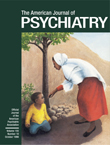To the Editor: We appreciate the opportunity to respond to the comments of Good and colleagues. To clarify the gender composition of our study group, there were 12 male and eight female younger patients, 13 male and seven female younger comparison subjects, five male and 13 female older patients, and six male and 14 female older comparison subjects. While there was a difference in gender distribution by age, there was no difference in the total numbers of men and women studied. The lack of a main effect of gender on performance on the University of Pennsylvania Smell Identification Test cannot, therefore, be explained by an unequal distribution of male and female subjects.
Concerning the interaction between gender and diagnosis, we reanalyzed our data as suggested by Good and colleagues. Our findings do not support their contention that “sex differences in olfactory function in schizophrenia are age related.” While we observed main effects of diagnosis (F=83.04, df=1, 70, p<0.0001), age (F=55.78, df=1, 79, p<0.0001), and a diagnosis-by-age interaction (F=43.43, df=1, 70, p<0.0001), there was no evidence for a main gender effect (F=1.23, df=1, 70, p=0.27), a gender-by-diagnosis interaction (F=1.79, df=1, 70, p=0.19), or an age-by-gender-by-diagnosis interaction (F=0.01, df=1, 70, p=0.93). Moreover, there is little evidence in the literature to support such a statement. Contrary to their own assertion that “female patients become impaired only postmenopausally,” Kopala et al.
(1) reported significant olfactory deficits in premenopausal schizophrenic women. Of the nine published studies that have included both male and female patients, only one
(2)observed a significant gender-by-diagnosis interaction. The four others reporting sex differences employed less stringent statistical models and/or questionable contrasts (e.g. schizophrenic men versus a pooled group of schizophrenic women, healthy men, and healthy women).
We also disagree that it is more appropriate to use a regression model based on the patients’ own age and gender to examine the effect of illness duration. Such a model implicitly assumes that the onset of schizophrenia occurs with equal frequency over the life span and that the illness itself does not interact with the aging process. Schizophrenia has its onset in late adolescence and young adulthood, and as a result, age and duration of illness are highly correlated. Moreover, since illness begins earlier in men, the effects of illness duration and gender are also confounded. Regressing out the normal effects of aging and gender, as we did, avoids such confounds.
Last, Good and colleagues are correct in noting that a curvilinear relationship between illness duration and olfactory deficit cannot be ruled out. However, duration of illness and performance on the University of Pennsylvania Smell Identification Test performance were highly correlated in both our young and elderly groups, and the rate of decline was identical across the two groups. The best approach to this problem is obviously a longitudinal study that examines within-subject decline over time. Within the stated limitations, however, we believe that the observed relationship between duration of illness and odor identification is valid.

